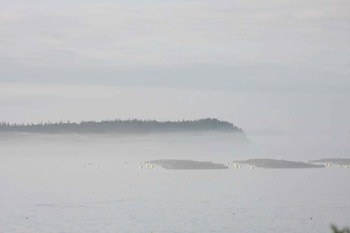Elevated Levels of Mercury Found in Fog

Coastal fogs may be delivering a large fraction of the mercury entering coastal ecosystems worldwide. In a recent report the first measurement ever reported from fog water, “(was) about five times the highest concentration ever seen in rainwater.” ©Sam Murfitt Photo
In horror movies, fog often provides creepy atmospherics, hiding threats from hideous creatures, bandits, ax murderers, and the like. Now, a new study suggests that fog can harbor real-life horrors. Researchers have found that coastal mists may carry toxic mercury that can harm ecosystems and human health.
Mercury pours into the atmosphere from coal-fired power plants and various industrial processes, including some used in refining ores and paper manufacturing. It’s a neurotoxin that isn’t easily excreted by organisms that ingest it, so it becomes increasingly concentrated in animals at higher levels of a food chain.
A well-absorbed form is monomethyl mercury, a positively-charged ion that readily binds with proteins and can be transported throughout the body, even across the blood-brain barrier into the brain and through the placenta into a developing fetus. Monomethyl mercury can impair neurological development in fetuses and young children, reducing memory, attention, and language and motor skills. In adults, exposure can impair peripheral vision, trigger a “pins and needles” feeling in the hands and feet, and lead to muscle weakness and a lack of coordination.
Most scientists presumed mercury deposited from the atmosphere came either from raindrops that had absorbed the element from the air or via “dry deposition” in which the vaporized atoms stick to or chemically react with an exposed surface, says Peter Weiss-Penzias, an atmospheric chemist at the University of California, Santa Cruz.
Now, field experiments conducted by Weiss-Penzias and his colleagues have identified another atmospheric source of mercury that’s likely to be substantial in some areas, especially along some coasts. At four locations in and around Monterey Bay, California, the researchers, using equipment that slurps up large quantities of air and retains any suspended particles, collected large volumes of fog droplets from June through August 2011.
In the 25 samples they analyzed, concentrations of all forms of mercury averaged 10.7 nanograms per liter, and levels of monomethyl mercury averaged 3.4 nanograms per liter, they reported last month in Geophysical Research Letters. The latter concentration, the first such measurement ever reported from fog water, “is about five times the highest concentration ever seen in rainwater,” Weiss-Penzias notes.
Using data from previous studies, including those of other teams, the researchers estimated that between 61 percent and 99 percent of the monomethyl mercury deposited in coastal ecosystems around Monterey Bay over the course of a year comes from fog.
The new findings don’t offer any ideas for minimizing mercury exposures in coastal environments, Weiss-Penzias says, but they do allow scientists to better understand how mercury may be making its way into those ecosystems.
Future experiments, he says, will include measuring mercury levels in creatures at the base of the food chain, such as insects that may be drinking mercury-tainted fog droplets that have condensed on coastal plants. “This is a very exciting piece of work,” says Mark Marvin-DiPasquale, a microbial ecologist with the U.S. Geological Survey in Menlo Park, California. The concentrations of monomethyl mercury the team measured “are way in excess of what anyone would have predicted,” he noted.
Some studies suggest that mercury also makes its way into the atmosphere over coastal waters when winds stimulate upwelling of waters from the sea floor, where sediment-dwelling microbes consuming mercury-tainted organic matter generate a compound called dimethyl mercury. When the contaminated waters reach the surface, the compound evaporates and is subsequently cleaved into several components, including monomethyl mercury, by chemical reactions driven by sunlight.
It’s not clear whether those reactions take place in the atmosphere or within fog droplets, Weiss-Penzias says, but in either case the monomethyl mercury ends up in the droplets, which can then be carried by winds to the coast.
“As the story goes, it’s a pretty neat one,” Marvin-DiPasquale says. And if the researchers are correct, he noted, other teams can readily develop models that estimate how much fog-delivered mercury is being deposited in coastal ecosystems elsewhere in the world. “This is probably not just a problem along the California coast.”
Sid Perkins
Science NOW
Pacific Coast Federation of Fishermen's Associations (PCFFA)
